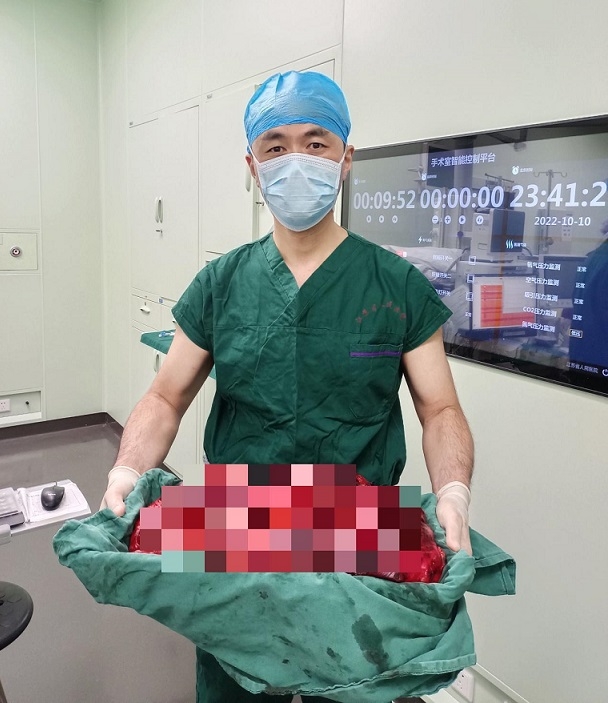Despair: Unfortunate to have a "super giant" retroperitoneal tumor
Wang and his wife both work in the IT industry. Two years ago, Wang, now in his 40s, suddenly noticed something strange about his body. "Because I live a healthy lifestyle, I pay attention to nutrition in my diet and I am not fat. I did not pay attention to it. I just bought an exercise belly wheel and practiced at home, but there was no effect." Mr. Wang recalled that after more than a year, he gradually found that he felt bloated after eating something. Until the end of September this year, he did a B-ultrasound examination and found that his kidney was missing! "Then we did a further CT imaging examination and found the growth of retroperitoneum. We immediately consulted domestic and foreign doctors, and many domestic hospitals told us there was nothing we could do. Later, we heard that Jiangsu Provincial people's central pancreas surgery was good, so we decided to let them try, and then we found Director Wu." Mr. Wang's wife said.
Professor Wu Junli, Deputy director of the Pancreatic Center, said that retroperitoneal tumors are located in a special place, often showing expansive growth, resulting in large tumors with no obvious symptoms, some tumors are highly malignant, surgical resection is currently the only possible treatment. "Wang's operation was more difficult than the usual retroperitoneal tumor resection, because after preoperative evaluation, the tumor had invaded several organs and blood vessels in the abdominal cavity, and it required the cooperation of a multidisciplinary team to remove it." Professor Wu Junli said.
Hope: Multidisciplinary collaboration to open the "window of Life"
As soon as Mr. Wang was admitted to the hospital, the one-stop multidisciplinary diagnosis and treatment team of the Pancreatic Center of Jiangsu Provincial People's Hospital conducted a detailed preoperative evaluation. After reviewing the radiographs, it was found that the patient's left kidney, descending colon, sigmoid colon, left common iliac artery, internal and external iliac artery, left iliopsoas muscle and left vas deferens were all invaded by tumors, and surgical resection required multiple organs and tissues. "It is feasible to remove the left iliopsoas muscle affected by the tumor, and patients can still walk after surgery, which can benefit from it," said Li Juming, chief orthopedic surgeon. "The invasion of the left iliac vessel can be separated on a trial basis, or it can be considered to directly perform vascular resection and reconstruction" Jiao Yuanyong, deputy chief physician of vascular surgery department, proposed. "The patient's left vas deferens is involved, and soft tissue shadow can be seen in the left inguinal canal. It is necessary to excise the left vas deferens and explore the left inguinal area" Chen Simeng, chief physician in charge of hernia and abdominal wall surgery in General Surgery Department, reminded...... After a full multidisciplinary discussion, the expert team finally determined to "take the risk" : "I consulted the relevant literature, such a big operation rarely reported, but the patient is still very young, we have no reason to give up, the whole operation and anesthesia team is confident and capable of winning this hard battle." Director Wu said.
After the surgery was decided, Mr. Wang underwent surgery on Oct. 10. "The operation was more complicated and difficult than expected. The tumor filled the entire abdominal cavity and pelvic cavity, leaving us with very limited operating space. The skilled and accurate cooperation of the surgical team, Deputy chief physician Lu Zipeng and attending physician Wu Pengfei, not only needed to support the huge and heavy tumor effortlessly and gently, but also needed to protect the surrounding normal tissue and avoid tearing the thin vascular wall where the tumor invaded." Chief physician Wu Junli introduced, "Intraoperative experts from multiple disciplines participated in the process of tumor resection. On the basis of joint resection of part of colon and left kidney, because the tumor violated the left iliopsoas muscle and left vas deferens, chief physician Li Juring of the Department of Orthopedics and chief physician Chen Simeng of the Department of hernia and abdominal wall surgery carefully explored and evaluated the site and extent of the invasion. While preserving the maximum physiological function, the damaged tissue was completely removed ", Director Wu said, the team also met great challenges during the operation. "When the separation of the left branch of the common iliac and internal and external iliac arteries was conducted, we found that the depth of the tumor invasion exceeded the artery membrane, and the artery sheath technique established by Professor Miao Yi in the pancreatic center could not be used for tumor separation as originally expected. When the team was deciding how to carry out vascular reconstruction, Jiao Yuanyong, deputy chief physician of vascular surgery, proposed that autologous normal internal iliac artery could be used to bridge the common iliac artery and external iliac artery, which not only ensured the complete resection of the tumor, but also ensured the patency of the blood supply to the lower extremities. With the dissection of the blood vessels, the tumor and the violated tissues and organs were finally completely removed." Director Wu said.
When the internal iliac artery segment was bridged to the residual end of the total iliac external iliac artery, and the anastomosis of open blood flow was quickly and accurately completed, everyone on site held their breath: the blood flow was unobtrusive, without leakage or stenosis! The surgical team breathed a sigh of relief. "It took 14 hours to maintain the patient's vital signs and keep all the indicators normal. It was a very difficult challenge for the anesthesiologist, but we did it!" With more than 30 years of clinical experience in anesthesia and perioperative medicine department, chief physician Zhou Qinhai sincerely sighed.
"It was probably the longest operation I've had in my career, from morning to early morning, but we were patient and managed the disease thoroughly and the complications very well." Wu Junli chief doctor said. After nine days of close observation in the intensive care unit of the Pancreatic Center, Mr. Wang was transferred back to the general ward. The postoperative recovery was much better than expected. Even Mr. Wang himself did not believe that such a big operation could recover so quickly. The pathological report showed that the tumor was liposarcoma with a volume of 54*31*11cm, the size of a newborn baby! Although the tumor invaded multiple organs and tissues of the patient, it was completely removed through the collaboration of the departments of pancreatic surgery, vascular surgery, orthopedics, hernia surgery and anesthesiology. The operation was very successful!
Breaking through discipline "bottleneck", multi-disciplinary team is "the key to success"
It is understood that surgeons face great challenges due to the special location of retroperitoneal giant tumors and the difficulty of operation. "Pancreatic surgeons deal with a variety of pancreatic diseases every day, but in the face of such complex retroperitoneal tumors, close collaboration with a multidisciplinary team, skilled surgical techniques, and first-class anesthesiology support are the keys to successful surgery and patient recovery." Wu Junli director said.







